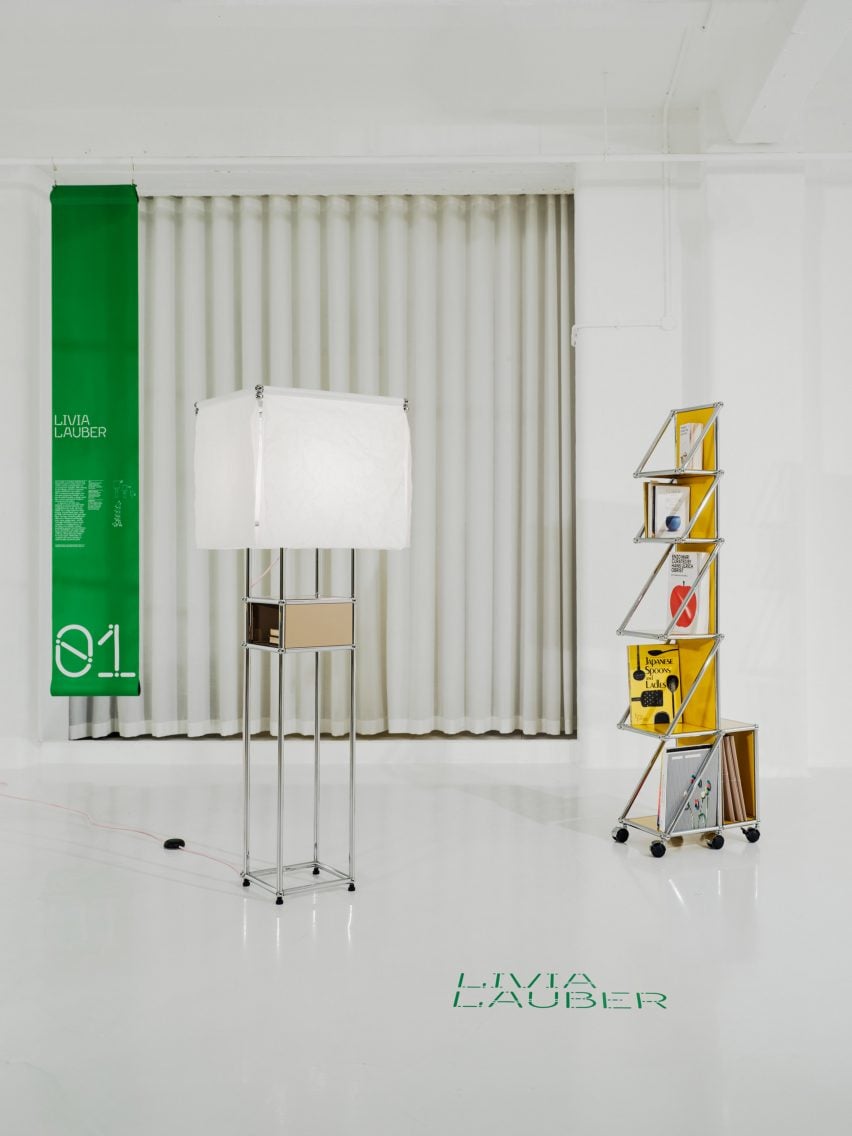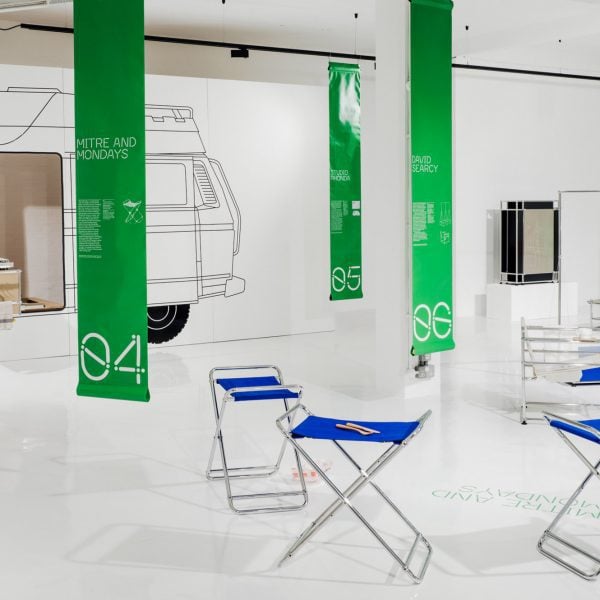London’s Aram Store has unveiled the Adaptations exhibition, in partnership with Swiss modular furniture brand USM, at its own gallery in Covent Garden.
The exhibition, which is taking place at the Aram Gallery in London, presents work by 10 studios and practitioners who used components from USM’s Haller modular system – normally used to create storage and display designs – to form different types of furniture.
The resulting pieces range from designs for the workspace to furniture for the home, and include a bookshelf and coffee table as well as storage for a camping van.
Aram selected the exhibiting studios and creatives based on what they could each individually bring to the project, with disciplines spanning architecture, art, textiles, interiors and product design.
“It was important to have people from a wide variety of creative practices as we wanted each piece to have its own distinct point of view,” Aram creative manager Grace Eden told Dezeen.
“Each exhibitor was chosen because we felt that they would understand and engage with the system.”

Design studio Mitre & Mondays utilises processes that prioritise disassembly, reuse and repair in its work, which holds similarities to USM Haller.
The studio constructed folding stools, designed to enhance its group lunches when working onsite in narrow London streets, from USM Haller components and textile slings for the exhibition.

Artist Issi Nanabeyin, meanwhile, adapted the Haller system by bending its shelf component and incorporating a laser-cut wheel and aluminium round tubes.
For Adaptations, he produced ResearchObject, a mobile bookstand designed to encourage collaboration, and DesignObject.
This is an adjustable drawing board that pivots from 10 to 40-degree angles to fit different needs within creative processes.
“We felt confident [Nanabeyin] would engage with the technical aspect of USM in a singular way,” said Eden. “His pieces were created to aid his artistic practice, but also mirror it in that they are highly articulated and moveable.”

Studio Rhonda founder Rhonda Drakeford created a pull-out storage unit for her Volkswagen campervan, identifying a similarity between the modularity of the USM Haller products and camping engineering.
The multi-functional shelf includes repurposed handles from the Haller trolley to hang utensils from, along with hand-burnished USM chrome frames to match the van’s interior surfaces.
“We felt Studio Rhonda would be sympathetic to USM Haller’s inherent values whilst also designing a striking piece,” Eden said.
“Her pull-out unit for her campervan was a perfect expression of the brief.”

Another practical design on show was the tool chest trolley by architect Jennifer Dyne, which slots into her existing workbench and was entirely composed of USM Haller pieces.
Designer Holly Rollins created Research Buereau, a multi-purpose workstation that integrates storage and seating, featuring a swing-out desk that uses the USM modular furniture ball as a pivot.

As well as objects designed for work environments, the exhibiting designers also created furniture and interior pieces for the home.
Designer David Searcy’s chair featured clothes rails that were integrated into its armrests for storage, while designer Si Hyun Park created a frame to present her drawings of London scenes.

A lamp by textile artist Mair Cook featured a handwoven lampshade that wraps around a USM storage structure, designed to create soft lighting suitable for Cook’s baby daughter.
“My daughter spent her first month in the neonatal intensive care unit, so I find I am grateful for the normalcy of touch and togetherness we were denied,” she said.
“The night feed is a sacred, quiet time of bonding for us, and the lamp will accompany us through the drowsy hours.”

Designer Livia Lauber designed pieces for both the workplace and the home using USM Haller, creating a bookshelf and a floor lamp.
The bookshelf – titled Bockself – was intended for her studio and constructed using custom-length diagonal support tubes. It features smaller shelves at the top and lower, sturdier shelves for heavier books.
The Usmo lamp has a hanging shade made of Japanese washi paper, creating a soft contrast to the Haller metal frame.

London-based designer Kengo Horikoshi took a more conceptual approach in his response to the brief.
Experimenting with the concept of a chair, Horikoshi explored the idea of a piece that evolves and adapts alongside its user, utilising Haller’s modular format and range of components.

Aram hopes that the exhibition can inspire visitors’ creativity whilst highlighting the possibilities of the USM Haller system.
“The wider intention of Adaptations is to celebrate and inspire creative thinking and instinctive, functional design,” said Eden.
The exhibition photography is by Jack Orton.
Adaptations takes place at Aram Gallery in London from 8 November to 14 December 2024. See Dezeen Events Guide for an up-to-date list of architecture and design events taking place around the world.

